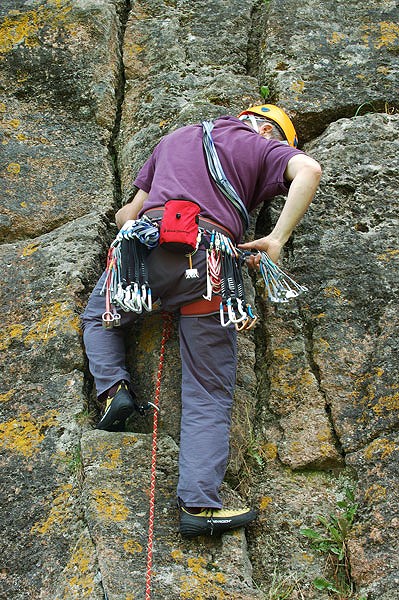
"In the 1950s, insurance companies began studying a disturbing trend: People who owned car insurance were more likely to be killed in automobile accidents than those who didn’t have coverage. Studies today indicate that mandatory insurance laws have caused a 6% to 10% increase in traffic fatalities since 1970. Insured drivers choose to go faster when they know their cars will be replaced after an accident.” Could our desire to protect ourselves and be safe actually cause us to be less protected and act in unsafe ways? Let’s see if we can answer this question, specifically in a climbing context.
Many climbers begin their climbing careers by top-roping first, then following, then leading sport climbs, and finally leading trad routes. At first glance this seems like a logical progression of gradual increasing risk. What is most important to become aware of is our intention within such a progression. People approach risk with one of two types of intention: to eliminate the consequences or to embrace the consequences.
Most climbers have the former intention [to eliminate the consequences] because that is the approach most people have in life itself. We tend to avoid risks and strive for a comfortable, secure life. In top-roping, if your intention is to eliminate the consequences, you’ll be less attentive to how you are belayed, the belayer’s experience with belaying, the placement and strength of the top-rope anchor, etc. With this as your intention, when you start leading, your attention will be focused on not falling. To take a fall would be risky and would be the manifestation of the consequence you originally intended to avoid. For example: Resisting the falling outcome will cause your attention to be focused on down-climbing, over-gripping, stopping climbing, hanging on pro, etc. In other words, your attention will be on what you need to do to prevent falling from occurring. However, when you fall [and you eventually will], you will have resisted this outcome so much that your attention will be totally distracted thereby increasing the chance of injuring yourself.
When you climb with the intention to embrace the consequences, you focus your attention on every aspect of the situation including the possible consequences. You approach the risk with acceptance. You know that you’ll eventually take a fall so you accept it. By accepting the possibility of a fall, you focus attention on learning about falling—the impact forces, how your belayer should belay you, how much slack to have in the system, your falling form, etc. Even if you don’t practice falling, you’ll still be less likely to resist a fall. In other words, you’ll be relaxed and attentive to how you need to respond to keep yourself as safe as possible in the fall.
Duhigg also states that prior to the 1990s, most psychologists believed that happiness, safety, and pleasure motivated most decisions. But some researchers since have concluded that people not only want to feel happy, they want to feel alive. This creates a problem. People want to feel alive but they strive for it with their intentions fixed on staying safe and secure. We truly feel alive when we challenge ourselves and when our attention is supremely focused in the moment. When our intention is on staying safe, secure and eliminating the consequences, we aren’t challenging ourselves so our attention is distracted. To have an experience of being alive we need to be engaged in the situation. A challenging situation, however, has unknown aspects to it which create consequences. When we resist these consequences we focus attention on things outside of the challenging situation. While we’re climbing, for example, our attention is on being finished with the climb, wishing the fall wasn’t so severe, not wanting to fall, etc--aspects that create a desire to make us comfortable, safe, and secure. Focusing attention in this way moves attention out of the moment and distract us. By not being in the moment we remove the experience of feeling alive. When our intention is on embracing the consequences, we look for ways to meet the challenge. This results in focusing our attention on the situation and the consequences. While climbing, for example, our attention is on what we need to do in the moment—where the holds are, where the next pro/rest is, how long the possible fall is, etc. With our attention in the moment we are deeply immersed in the situation and therefore feel most alive.
There isn’t anything wrong with the top-rope-to-leading-trad progression as long as your intention is on embracing the consequences. However, I advocate leading right away. Doing so makes you acutely aware of the consequences. Too many climbers get into the sport thinking that climbing is safe. Climbing isn’t safe; it’s dangerous. You can make it safer but you cannot make it safe. With this awareness your attention is focused effectively on the situation and the consequences. You’ll be less likely to feel safe and protected, and therefore act in ways that keep you as safe as possible. It’s a paradoxical world. Only by accepting and embracing the risk and consequences do you respond appropriately to those risks and consequences. As a result, you’ll understand how climbing fits into your life and how it satisfies your need to feel alive.
Arno Ilgner is founder and president of Desiderata Institute, a multi-faceted medium which includes the Warrior's Way Course — designed to specifically help climbers overcome mental obstacles that are inhibiting their performance. Since 1973 Arno has developed and perfected specific physical and mental training methods, which are not only unique but highly effective as well. These methods are taught in the Warrior's Way Course. Through the Institute he also guides clients on mountains and cliffs in the Southeast USA. He served as a platoon leader in the US Army with tours of duty in Korea and Colorado has been a member of the American Alpine Club since 1983. He co-authored the first guide book to Fremont Canyon in Wyoming, and has published articles in Rock & Ice, Boulderdash! and Climbing magazines. Arno's interests range from mountaineering, to sport climbing, long free traditional routes, to big wall climbing.

His book The Rock Warrior's Way: Mental Training for Climbers is available from his websiteThe Warrior's Way and from Amazon
